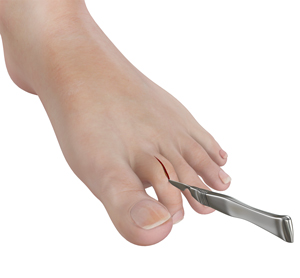
Lesser Toe Correction Surgeon
Painful deformities of the lesser toe include hammer toe, claw toe, and mallet toe among others. When conventional treatments fail to resolve a deformity of the lesser toe, it is corrected through surgery. Dr. Brady provides expert diagnosis and individualized non-operative and operative treatments for the lesser toe including correction of the lesser toe. Dr. Brady also provides highly specialized care during and after surgery. Contact Dr. Brady’s team for an appointment today!

What is Lesser Toe Surgery?
Lesser toe surgery is an operation to correct deformities of the lesser toes other than the big toe. Some of the common lesser toe deformities include hammer toe, claw toe, and mallet toe.
Anatomy of the Foot
Anatomically, the foot is divided into the forefoot, mid foot and hind foot. The forefoot has 4 small toes called phalanges and 1 large toe called the hallux or big toe. Phalanges have 3 bones and 3 joints, while the big toe has 2 bones and 2 joints. The mid foot and hind foot have different structures, which are responsible for bearing body weight and performing activities such as walking and running.
Indications for the Surgery
Lesser toe surgery is recommended when non-surgical treatments fail to resolve the deformities of the lesser toe. Some of the common indications for the procedure include:
- Painful deformities of the lesser toe
- Pressure in the balls of the feet
- Pressure under the tip of the toe
- Pressure on the corns on top of the toes
- Difficulty walking and wearing shoes
- Callus formation and swelling in the joints
Preparation for Surgery
Your surgeon will brief you about the pre-surgery protocols and instruct you to do the following as necessary:
- Attend a preoperative assessment appointment 2-6 weeks before your surgery.
- Stop taking anti-inflammatory medications seven days prior to the procedure.
- Arrange a driver to take you home after the procedure.
- Arrange a caregiver to help you at home after the surgery.
How is Lesser Toe Surgery Performed?
The surgery is performed under general anesthesia. The choice of operation depends on the type and severity of the deformity which you should discuss with your surgeon.
Postoperative Care and Instructions
As you recover, you are advised to:
- Keep the dressing on the foot until it is removed by your surgeon’s team at your post-operative appointment.
- Keep the incision dry until the wounds are thoroughly healed and you are instructed it is ok to get it wet by your surgeon.
- Rest your foot completely for 2-4 days.
- Keep your foot elevated as much as possible for the first couple of weeks.
- Keep your foot dry at all times.
- Discuss weight bearing with your surgeon because it will be determined by how extensive your surgery was.
- Adhere to prescribed pain medications.
- Adhere to instructions on diet, incision site care, bathing, and driving.
- Adhere to scheduled follow-up appointments to monitor your progress.
Risks and Complications
Some of the common risks and complications of lesser toe surgery include:
- Toe stiffness
- Injury to nerves and vessels
- Persistent swelling
- Infection
- Blood clots
- Bleeding
- Numbness or loss of sensation
- Non-union of bones
- Recurrence of deformity
- Reaction to the anesthesia
- Possibility of revision surgery
Benefits of Lesser Toe Surgery
Potential benefits of lesser toe surgery include:
- Reduced misalignment, pain and deformity
- Less or no formation of callus or corn
If you would like to have additional information on the treatment of lesser toe deformities or would like to learn more about lesser toe correction surgery, please contact Dr. Brady, serving the communities of California.








